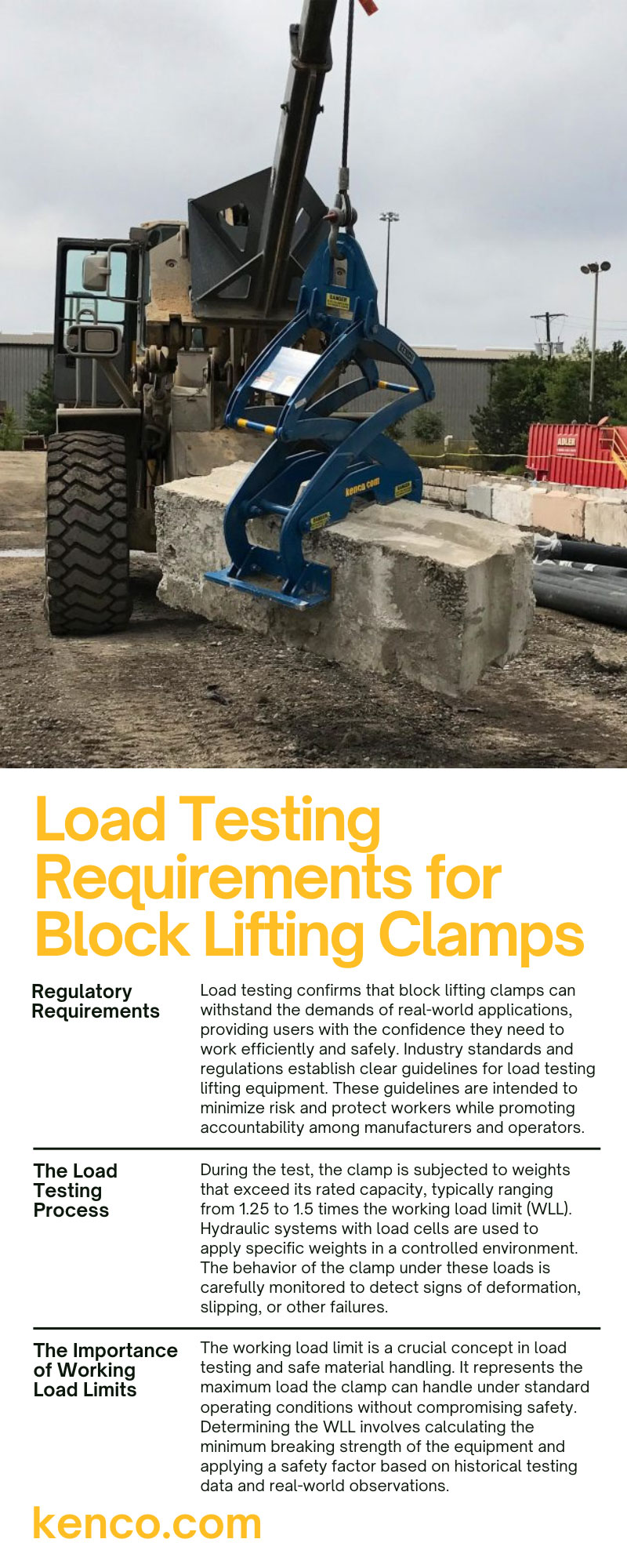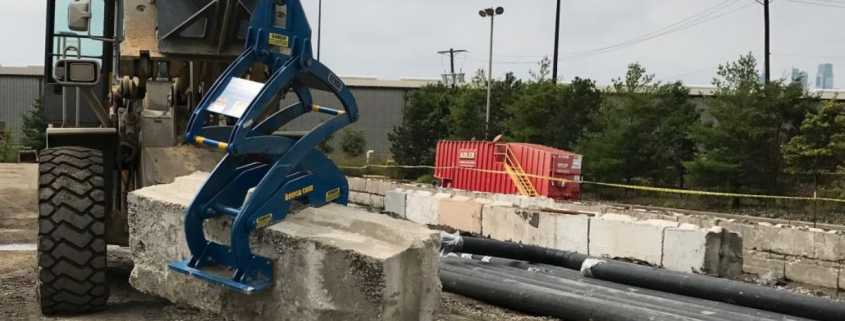Load Testing Requirements for Block Lifting Clamps
Lifting heavy materials safely requires equipment that performs reliably under challenging conditions. Among the many tools used in construction and industrial operations is the block lifting clamp, a device designed specifically for lifting and handling heavy concrete blocks.
Rigorous load testing requirements for block lifting clamps ensure their functionality, durability, and compliance with industry safety standards. Being aware of load testing, its requirements, and best practices promotes worker safety and prolongs the equipment’s lifespan.
The Purpose of Load Testing
Load testing requirements for block lifting clamps are necessary for determining whether they can support their rated capacity safely and efficiently. This process subjects the clamp to static and dynamic forces that simulate real-world conditions, confirming its structural integrity and operational reliability.
Static testing measures the equipment’s ability to hold a weight in place without failure, while dynamic testing examines its performance while lifting, moving, and lowering loads. Thorough testing helps identify any weak points in the clamp’s materials and design, guaranteeing that only high-quality equipment reaches the jobsite. For end users, this provides peace of mind and helps prevent dangerous equipment failures during operation.
Regulatory Requirements
Load testing confirms that block lifting clamps can withstand the demands of real-world applications, providing users with the confidence they need to work efficiently and safely. Industry standards and regulations establish clear guidelines for load testing lifting equipment. These guidelines are intended to minimize risk and protect workers while promoting accountability among manufacturers and operators.
The Occupational Safety and Health Administration (OSHA) and the American Society of Mechanical Engineers (ASME) set these standards. OSHA requires that all lifting equipment undergo proof testing before use at 125% of the equipment’s rated load. This testing must be documented, and records should remain available for inspection.
Similarly, ASME standards, such as B30.20 and B30.26, outline the operational and inspection procedures necessary for lifting devices. These include periodic testing schedules to ensure ongoing compliance with safety benchmarks, as well as standards for components such as shackles and other attachments used with block lifting equipment.
The Load Testing Process
The load testing process involves multiple stages to ensure a thorough evaluation of each block lifting clamp. Before testing, operators conduct a visual inspection to identify any preexisting defects, such as corrosion, bends, or wear. This guarantees the equipment is in good condition for testing and removes potential risks during the process.
During the test, the clamp is subjected to weights that exceed its rated capacity, typically ranging from 1.25 to 1.5 times the working load limit (WLL). Hydraulic systems with load cells are used to apply specific weights in a controlled environment. The behavior of the clamp under these loads is carefully monitored to detect signs of deformation, slipping, or other failures.
After the load test, the clamp undergoes a detailed inspection to identify any structural or mechanical changes resulting from the test. Documentation of both the test results and inspection findings is critical, as these records ensure traceability and compliance with OSHA and ASME regulations.
The Importance of Working Load Limits
The working load limit is a crucial concept in load testing and safe material handling. It represents the maximum load the clamp can handle under standard operating conditions without compromising safety. Determining the WLL involves calculating the minimum breaking strength of the equipment and applying a safety factor based on historical testing data and real-world observations.
For example, a block lifting clamp must be capable of holding its WLL during regular use, with room to endure occasional safety margins during emergencies or unexpected stress. Retaining accurate WLL markings on equipment also prevents confusion among operators and ensures adherence to best practices during lifting operations.
Post-Test Inspections and Maintenance
Following each load test, thorough inspections are vital for ensuring the equipment’s safety and readiness for future use. Sometimes a clamp may pass the initial load test but exhibit minor signs of wear or damage that could compromise its performance over time. These inspections focus on critical components such as gripping surfaces, welds, pins, and latches. Inspectors also ensure that key identifiers, such as the WLL, remain legible and securely affixed.
Regular maintenance complements these inspections. Lubricating pivot points, replacing worn parts, and addressing minor repairs promptly help extend the lifespan of the lifting clamp. By combining inspections with proactive maintenance, business owners can maximize their return on investment while minimizing risk.
Preventing Equipment Failures
Equipment failures are often the result of skipped inspections, inadequate maintenance, or improper usage. A poorly tested clamp can fail under load, leading to unsafe work conditions, delays, and potential legal liabilities.
To prevent such failures, companies should establish strict guidelines for equipment testing and inspection, integrating them into daily operations. Training employees to recognize and report defects also enhances safety and ensures hazardous equipment is removed from service immediately.
Technological Advancements in Load Testing
Technology improves the accuracy and performance of load testing processes. Digital load sensors, advanced hydraulic systems, and data recording tools allow for more precise measurements to make sure that lifting clamps meet stringent safety standards. These advancements also reduce time and labor costs associated with traditional testing methods, making compliance more accessible to businesses.
Kenco incorporates many of these technologies into our testing processes, reflecting a commitment to maintaining industry-leading safety and performance. By leveraging technology, our team designs block lifting clamps that consistently exceed expectations.
Real-World Applications of Load Testing
The effectiveness of a rigorously tested block lifting clamp becomes evident in practical, real-world applications. Whether you’re transporting large precast blocks for construction projects or repositioning materials in tight spaces, reliability is nonnegotiable. Jobsites benefit from fewer interruptions, less downtime, and a safer working environment when equipment meets load testing requirements.
For contractors handling repetitive or heavy-duty lifting tasks, equipment that has undergone thorough testing ensures dependable performance. It also reduces expenses related to repairs or replacements due to unforeseen failures.
Long-Term Benefits of Compliance
Adhering to load testing requirements is a practice that yields long-term benefits for businesses. By investing in tested and certified equipment, companies avoid accidents, minimize downtime, and establish trust with employees and clients. Furthermore, compliance with OSHA and ASME standards ensures reduced liability and a positive safety record, which can be critical when bidding for contracts.
Kenco’s emphasis on quality and compliance, combined with our dedication to customer support, makes us a valuable partner for businesses seeking reliable lifting solutions. Our team’s efforts help companies maintain operational efficiency while prioritizing safety.
Companies that prioritize compliant and thoroughly tested lifting equipment cultivate safer workplaces and more successful operations. Investing in these practices today secures long-term benefits for tomorrow’s projects.




Leave a Reply
Want to join the discussion?Feel free to contribute!